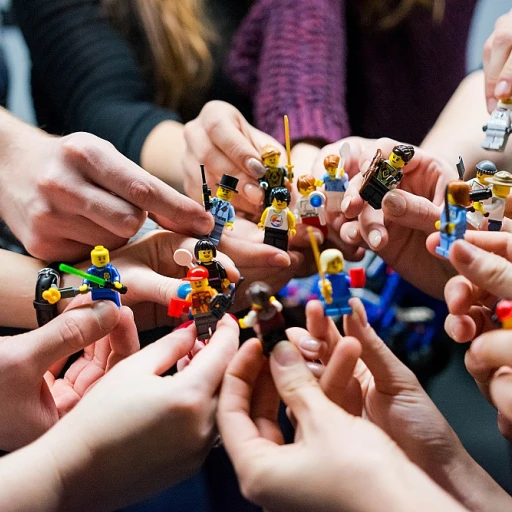The Heart of Peer Mentoring
The Essence of Peer Mentoring
In today's fast-paced world, the landscape of personal and professional development continues to evolve. Amidst myriad of approaches, peer mentoring emerges as a powerful tool, one that forges strong connections and facilitates growth. Whether in academic settings or within the corporate sector, peer mentoring stands as a beacon, transcending traditional learning methods and enriching the journey towards success. Peer mentoring thrives on symbiosis—a relationship where both parties, mentors and mentees, exchange knowledge and skills in a mutually beneficial environment. This distinctive approach not only bridges the gap between experience and ambition but also cultivates a sense of community and belonging. In subsequent sections, we will delve deeper into how these symbiotic connections lead to benefits that resonate on various levels. At the heart of peer mentoring lies open communication. The dynamic exchange between peers allows for the balancing of ideas, challenge of norms, and sharing of insights that lead to organic learning experiences. Merging the roles of mentor and mentee, participants find themselves in a progressive cycle of growth and learning. The journey of peer mentoring is not limited to the individual's gain alone. As we explore real stories of impact later on, it becomes evident that the ripple effects can reach far and wide, affecting teams and broader organizational cultures. Understanding the role each participant plays is crucial to maintaining productive mentorship relationships, which will be explored in detail in upcoming sections. Recognizing the inherent challenges that come with establishing such mentorship programs is equally important. Anticipating and overcoming these can pave the way for a well-structured, successful peer mentoring framework. Join us as we unravel how these challenges can be effectively addressed.Benefits That Speak Volumes
A Catalyst for Personal and Professional Growth
Peer mentoring is a transformative experience that speaks volumes in both personal and professional realms. It's a collaborative relationship where both mentors and mentees find themselves on a journey of mutual development. In a world that increasingly values diverse perspectives, peer mentoring shines as a potent catalyst for growth. It fosters an environment where individuals can harness their knowledge, skills, and experiences to help each other succeed. Through this collaborative process, mentors and mentees alike enhance their communication skills, emotional intelligence, and leadership abilities.Breaking Down Silos and Building Connections
One of the less obvious yet impactful benefits of peer mentoring is its ability to break down silos within organizations. By pairing individuals across different teams or departments, it encourages the sharing of ideas and strategies that drive innovation. This cross-pollination of thoughts not only leads to creative solutions but also strengthens organizational culture. Moreover, the connections built through peer mentoring often extend beyond the formal boundaries of the program. Many participants find themselves building lifelong professional networks, which can be invaluable throughout their careers. As we'll explore further, these real-life stories illustrate the enduring impact of these relationships.Empowered by Feedback and Mutual Support
Feedback is a crucial element of any successful mentoring relationship, and peer mentoring is no exception. By offering constructive feedback in a safe space, mentors and mentees can address weaknesses and amplify strengths. This reciprocal nature of learning and teaching creates a supportive atmosphere, empowering participants to confidently tackle challenges. This empowerment doesn't stop at personal development. It enhances job satisfaction and can lead to higher productivity, ultimately benefiting the entire organization. As we delve into building successful peer mentoring programs and overcoming potential challenges, it's clear that the benefits are indeed wide-reaching and profound.Real Stories, Real Impact
Inspiring Journeys: Transformative Experiences in Peer Mentoring
Peer mentoring has often acted as a catalyst for unprecedented personal and professional growth. When stories of success are exchanged among peers, the raw power of mentoring reveals its essence—the ability to effect change through shared experiences. Take the story of Emily and Alex, as an example. Emily, an ambitious marketing professional, found herself at a crossroads in her career. Feeling stagnant and unsure of her next steps, she turned to her peer mentor, Alex, who had navigated similar challenges. Through regular sessions, they shared strategies and insights, empowering Emily to explore new avenues and successfully pivot within her organization. This real-life transformation highlights how peer mentors are not just guides but rather agents of change who encourage mentees to reflect on their aspirations and unlock their potential. Another testimony comes from an innovative engineering firm. When they established a peer mentoring program, they encouraged team members to expand their horizons beyond departmental silos. One mentee, Jamal, found inspiration in his mentor's journey of innovation and collaboration, which led him to spearhead a successful cross-departmental project. Such real-world narratives demonstrate that genuine connections within a peer mentoring framework unlock powerful opportunities for professional breakthrough. If you're considering implementing such programs, remember that the benefits are not restricted to career advancements alone. Personal growth such as increased confidence and enhanced communication skills are also significant outcomes, underpinning the journey to success that peer mentoring fosters. For a deeper understanding of how mentoring can transform careers and personal lives, explore this resource on professional mentoring.The Role of Mentors and Mentees
The Dynamic Duo: Mentors and Mentees
Understanding the symbiotic relationship between mentors and mentees is pivotal in harnessing the full potential of peer mentoring. At its core, this relationship thrives on mutual respect, communication, and a shared commitment to growth. While each plays a distinct role, both parties are equally essential to the mentoring equation. Mentors, often viewed as the guiding light, have the responsibility of leading by example. They are not just teachers or supervisors; they are role models who provide constructive feedback, impart wisdom, and cultivate an environment where mentees feel comfortable exploring new ideas. A good mentor doesn't give all the answers but rather helps the mentee develop critical thinking and problem-solving skills. On the other hand, mentees are not mere recipients in this relationship. Active participation and engagement are expected of them. A successful mentee displays eagerness to learn and grow, poses thoughtful questions, and takes initiative in setting and pursuing personal and professional goals. The best mentees know how to leverage the guidance provided and apply it effectively to their unique situations. Furthermore, both mentors and mentees benefit from periodically reassessing the relationship. This ensures that the goals and objectives remain aligned, addressing any evolving needs or challenges that may arise. Regular check-ins and open dialogue can prevent misunderstandings and promote ongoing development. In many cases, mentors themselves gain invaluable insights from their mentees, leading to a reciprocal learning experience. Through this exchange, mentors can refine their leadership skills, stay updated with modern trends, and foster a culture of continual learning. Ultimately, the mentor-mentee relationship is a partnership where learning occurs bi-directionally. By embracing their roles with enthusiasm and dedication, both participants can unlock transformative personal and professional growth, enriching not only their own lives but also the broader landscape of their fields.Building Successful Peer Mentoring Programs
Crafting the Foundation for Effective Peer Mentoring
Establishing a successful peer mentoring program involves more than just pairing individuals together. It's about creating an environment where both mentors and mentees can thrive, building upon the insights shared in earlier sections about the heart and benefits of peer mentoring. To start, it's crucial to define clear objectives for the program. What do you hope to achieve? Whether it's improving skills, enhancing career growth, or fostering a supportive community, having a well-defined goal will guide the structure and activities of your mentoring program. Next, consider the matching process. The most effective peer mentoring relationships often stem from thoughtful pairings. Aligning mentors and mentees based on their skills, experiences, and goals can lead to more meaningful interactions and outcomes. This is where understanding the roles of mentors and mentees, as discussed previously, becomes invaluable. Training is another key component. Providing mentors with the right tools and resources ensures they are equipped to offer valuable guidance. Likewise, mentees should be encouraged to actively engage and take ownership of their learning journey. Finally, regular feedback and evaluation are essential. By continuously assessing the program's effectiveness, you can make necessary adjustments to enhance its impact. This iterative process helps in overcoming challenges and ensures the program remains aligned with its objectives. By carefully crafting each element of your peer mentoring program, you create a platform where real stories of growth and success can flourish, echoing the profound impacts shared earlier.Overcoming Challenges in Peer Mentoring
Addressing Common Hurdles in Peer Mentoring
Embarking on a peer mentoring journey is an enriching experience, but it is not without its challenges. Recognizing and overcoming these obstacles is crucial for the success of any mentoring program. As discussed in earlier sections, the heart of peer mentoring lies in the mutual growth of both mentors and mentees, which requires navigating potential difficulties with care and strategy.
Communication Barriers: One of the most common challenges in peer mentoring is communication. Differences in communication styles or misunderstandings can hinder the mentoring relationship. To address this, establish clear communication guidelines from the outset. Encourage open dialogue and provide training on effective communication techniques to ensure both parties feel heard and understood.
Time Constraints: Balancing mentoring sessions with professional and personal commitments can be daunting. It's essential to set realistic expectations regarding time investment. Encourage mentors and mentees to schedule regular, but flexible, meetings that accommodate both parties' schedules. This approach fosters consistency without overwhelming either participant.
Mismatch in Expectations: Sometimes, mentors and mentees may have differing expectations from the relationship. To mitigate this, it's important to have a clear discussion about goals and objectives early in the process. This ensures alignment and helps in setting achievable milestones, which can be revisited and adjusted as needed.
Lack of Structure: Without a structured framework, mentoring sessions can become unproductive. Providing a loose agenda or framework can help guide conversations and keep the mentoring process on track. This structure should be flexible enough to allow organic growth but firm enough to ensure progress.
By proactively addressing these challenges, peer mentoring programs can thrive, leading to the profound benefits highlighted in previous sections. The key is to remain adaptable and committed to the shared journey of growth and development.










